 |
 |
 |
| |
Safety and Antiviral Activity of Fosamprenavir/Ritonavir (FPV/RTV) QD Regimens in HIV-Infected Pediatric Subjects
Ages 2 to 18 Years (48 week Interim Data, Study APV20003)
|
| |
| |
Reported by Jules Levin
CROI, Feb 2007, Los Angeles
Ellen Gould Chadwick*1, William Borkowsky2, Claudia Fortuny Guasch3, Juan Antonio Leon Leal4, Maria Neves5, NG Hartwig6, Guido Castelli Gattinara7, Naomi Givens8, Cindy Garris9, and Irene Gray9
1Children's Memorial Hospital, Chicago, IL, US; 2New York University Medical Center, New York, NY, US; 3H. San Juan de Dios, Servicio de Pediatría, Barcelona, Spain; 4Hospital Infantil Virgen del Rocío, Sevilla, Spain; 5Hospital Fernando Fonseca, Amadora, Portugal;
6Sophia Childrens Hospital, Rotterdam, Netherlands; 7Ospedale Pediatrico Bambino Gesu, Rome, Italy; 8GlaxoSmithKline, Greenford, UK; and 9GlaxoSmithKline, Research Triangle Park, NC, US
AUTHOR CONCLUSIONS
FPV/RTV was generally well tolerated in this pediatric population with a profile consistent with adult experience; no new safety concerns were identified with either the FPV oral suspension or tablet formulation
The occurrence of grade 3/4 neutropenia was confounded by concomitant medications and sample degradation.
Good antiviral responses were demonstrated particularly when one considers the baseline resistance profile of the populations
All data from this study, including PK, safety and antiviral response data are currently being reviewed by regulatory authorities for assessment of a pediatric
indication.
ABSTRACT
Background: The HIV-1 protease inhibitor (PI) fosamprenavir (FPV) is being studied in PI-naive and experienced (exp) HIV-1 infected pediatric subjects ages 2-18 years to determine the pharmacokinetics (PK), safety and antiviral activity of FPV boosted with ritonavir (FPV/RTV) QD. PK data will be presented at a later time.
Methods: Prospective, open label, multi-center, 48-week cohort study. Formal statistical hypothesis testing was not performed in this non-comparative study (cut-off date 16 February 2005). All subjects began study taking FPV/RTV QD. Subjects were allowed to switch to a FPV/RTV BID regimen after data
in PI-exp adults demonstrated improved responses with BID dosing.
Results: 69 HIV-1 infected subjects were enrolled and received at least one dose of FPV/RTV. At Baseline, 32/69 were PI-naive and 37/69 were PI-exp. Seventeen subjects were aged 2-5 years, 17 were aged 6-11 years, and 35 were aged 12-18 years. 57% of subjects were female and 51% were white. Median Baseline HIV-1 RNA was 4.7 log10 c/mL for PI-naive and 4.9 log10 c/mL for PI-exp subjects. ABC/3TC was the most common initial background ART (46%). Ten subjects, 3 PI-naive and 7 PI-exp subjects, switched from FPV/RTV QD to BID with a median time to switch of 45 weeks (range:16-103 weeks).
Overall, median exposure to FPV/RTV was 72 weeks (range: 0-134 weeks) with 70% exposed >48 weeks. 30/69 (43%) subjects discontinued their treatment regimen prematurely [AEs (n=10), viral non-response (n=5), other (n=15)].
HIV-1 RNA <400c/mL (ITT[E],TLOVR) among PI-naive and exp subjects at Weeks 24/48 was 66%/47% and 57%/43%, respectively. Median increase in CD4+ cell percentages at Week 48 were 10% for PI-naive and 5% for PI-exp subjects. Drug-related Grade 2-4 AEs occurred in 19/69 (28%); the most frequent were vomiting (5/69, 7%), diarrhea (3/69, 4%) and nausea (3/69, 4%). Fourteen subjects experienced SAEs and three were drug-related. The most common SAE
was hypersensitivity to abacavir (n=3), followed by pyrexia (n=2). The incidences of treatment-emergent Grade 3/4 clinical chemistry and hematology abnormalities were 6/66 (9%) and 14/66 (21%), respectively. Neutropenia accounted for 13/14 Grade 3/4 hematology abnormalities, and was confounded by concomitant medications and sample degradation.
Conclusions: Following a median duration of 72 weeks exposure, the FPV/RTV regimen was generally well tolerated and demonstrated antiviral activity in PI-naive and PI-exp 2-18 year old pediatric subjects.
INTRODUCTION
Currently only five protease inhibitors are approved for use in the treatment of children with HIV. Of these, only three are available in liquid formulation, and each has their individual limitations, including large dosing volumes and/or unappealing taste. The need remains for new and improved potent PI antiretroviral therapies with pediatric indications and formulations.
Fosamprenavir (FPV), a pro-drug to amprenavir (APV), was developed to improve drug delivery of APV and has the advantage of improved water solubility compared to APV. This means that a higher concentration of drug can be dissolved in a smaller volume allowing for reduced volumes of the drug to
be administered. In addition, the FPV oral suspension formulation has minimal propylene glycol which would allow administration to children of any age.
APV20003 was designed to evaluate FPV/RTV QD dosing in HIV-1 infected pediatric subjects ages 2 to 18 years of age who are ART-naive or ART-experienced.
METHODS
APV20003, was an international (North America and Europe), 48-week, Phase II, open-label, multi-cohort, multicenter study conducted in 69 HIV-1 infected, ART-naive or ART-experienced pediatric subjects 2 to 18 years old.
Dosing was designed to deliver similar plasma APV concentrations as achieved in adults receiving FPV/RTV QD, and was initially FPV/RTV 30/6 mg/kg QD for all age groups. The study was amended after approximately one year to allow, based on investigator discretion, those subjects who were PIexperienced
at Baseline/Day 1 to either maintain their current FPV/RTV QD regimen or to switch to a FPV/RTV BID regimen (FPV/RTV 20/4 mg/kg BID for subjects ages 2 to 5 years or FPV/RTV 15/3 mg/kg BID for subjects 6 to18 years). This amendment was implemented based on data from the PI-experienced adult FPV/RTV study, showing improved antiviral response rates with FPV/RTV BID dosing in PIexperienced subjects.
Subjects were given FPV and RTV as investigational products to be used with a background regimen of two active NRTIs. FPV was administered as either oral 700mg tablets (if subjects weighed ≥50 kg) or 50mg/mL oral suspension. RTV was given as either 100mg capsules (if subjects weighed ≥33 kg) or as
an 80mg/mL oral solution.
The primary endpoints of the study are plasma APV AUC(0-_), Cmax, and C_ (not presented), the proportion of subjects who permanently discontinue FPV/RTV QD due to AEs, and the incidence and nature of AEs and laboratory abnormalities in study subjects. Antiviral response is a secondary endpoint.
As this is a non-comparative study, no formal statistical hypothesis testing was performed in this analysis and no power calculations were performed in order to derive the sample size. Recruitment of 62 subjects was considered an appropriate number to obtain robust information on the safety and tolerability following administration of FPV/RTV QD.
Only descriptive methods were used for the analysis of antiviral activity and safety assessments. Time to loss of virologic response (TLOVR) analysis and ‘observed’ analysis were used for the summary of proportion endpoints using viral load data. For TLOVR analysis, positive responders were those who had
a confirmed plasma HIV-1 RNA response <400copies/mL prior to the visit of interest, but without having experienced treatment failure. Treatment failure was defined as the first of the following events: confirmed plasma HIV-1 RNA ≥400 or 50copies/mL, permanent discontinuation of study drug or death Both Intent to Treat Exposed [ITT(E)] and Safety populations included all subjects with documented evidence of having received at least one dose of investigational treatment.
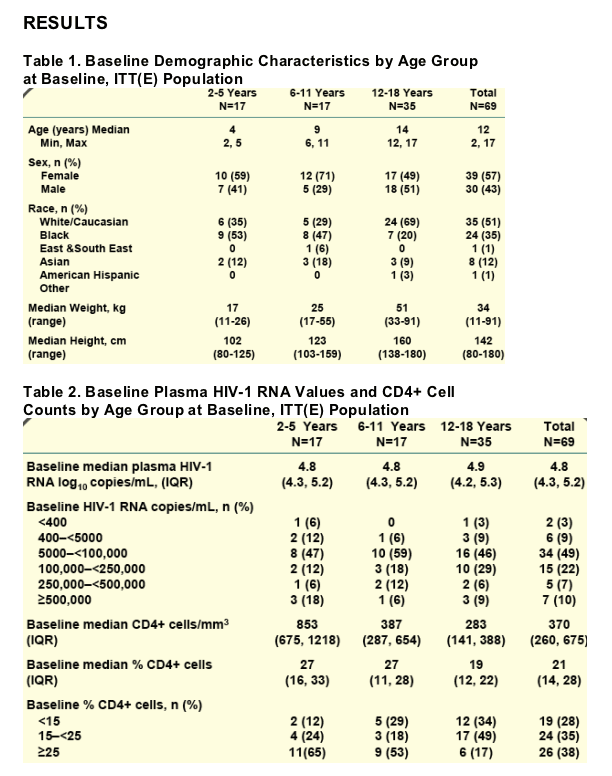
For CDC classification in children <13 years, the subjects in the study were fairly evenly distributed across the three CDC classes. Those subjects >13 years of age were primarily CDC Class B.
Seventy-eight percent (54/69) of subjects were ART experienced, with 22% (15/69) subjects being entirely ART naive.
There were differences in BL resistance profile by age. A greater proportion of the 12 to 18 year group had >3 RT mutations (43%) when compared to the other groups (23% and 13% for 2 to 5 and 6 to 11 age groups, respectively). The NRTI mutations observed most frequently were the thymidine analog mutations (TAMs) in 29/53 (55%) subjects. The proportion of subjects with primary PRO mutations
was 33% (4/12) in the 2 to 5 year age range, 33% (5/15) in the 6 to 11 year age range and 17% (5/29) in the 12 to 18 year age range; of those with primary PRO mutations, three subjects had IAS-defined APV resistance associated mutations.
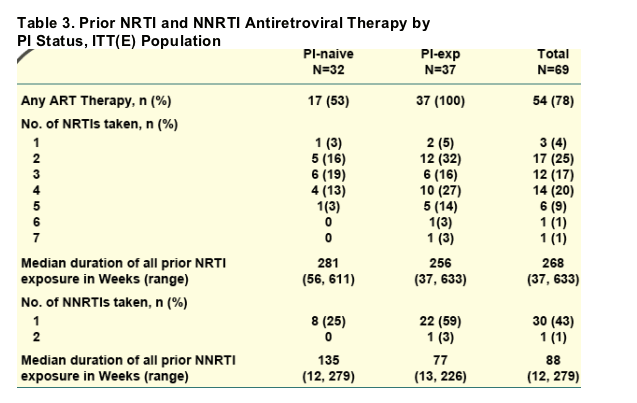
Most PI-experienced subjects (59%, 22/37) had one prior PI exposure with only 4 subjects having three prior PI exposure, with the median duration of prior PI exposure of 148 weeks.
The majority of the FPV/RTV exposure was on a QD regimen, with a median duration of exposure of 430 days (range 1-893). Ten subjects switched to a FPV/RTV BID regimen (all based on investigator discretion, following amendment), with a median duration of exposure to the BID regimen of 303 days (range 29-457). Of those subjects, the time to switch was a median of 312 days (range 110-722).
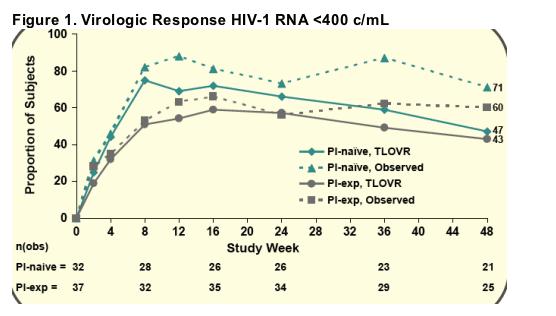
In the ITT (E) TLOVR analysis, the proportion of subjects with plasma HIV-1 RNA <400copies/mL at Week 24 was 66% and 57% in the PI-naive and PI-experienced groups, respectively and 47% in the PI-naive group and 43% in the PI-experienced group at Week 48. In the ITT (E) TLOVR analysis, the
proportion of subjects with plasma HIV-1 RNA <50copies/mL at Week 24 was 47% and 41% in the PI-naive and PI-experienced groups, respectively and 41% in the PI-naive group and 35% in the PI-experienced group at Week 48.
In the TLOVR analysis for the 15 ART naive subjects, the proportion of subjects with plasma HIV-1 RNA <400 copies/mL at Week 48 was 67% (10/15). Two ART naive subjects experienced virological failure, and three prematurely discontinued FPV/RTV (2 due to an AE, and one due to not meeting target PK levels).
The 2 to 5 year old age group had the largest proportion of subjects (65%) with HIV-1 RNA levels <400copies/mL at Week 48, compared to 47% in the 6 to 11 year old age group and 34% in the 12 to 18 year old age group.
The median CD4+ cell count at Baseline was 357 cells/mm3 in the PI-naive group and 379 cells/mm3 in the PI-experienced group. At Weeks 24 and 48, the median % CD4+ cell count change from Baseline was 5% and 10%, respectively in the PI-naive group, and 4% and 5%, respectively in the PI-experienced group.
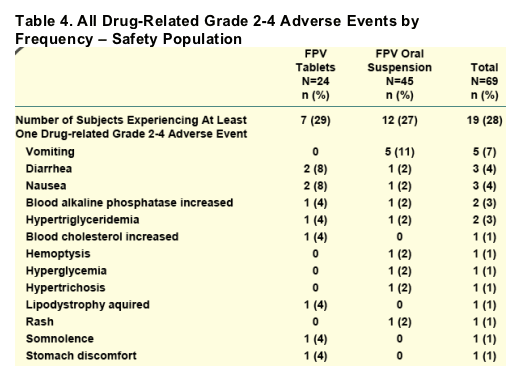
The overall frequency of drug-related Grade 2-4 adverse events reported by age group was 35% (6/17) in subjects 2 to 5 years, 12% (2/17) in 6 to 11 year olds and 31% (11/35) in 12 to 18 year olds.
Ten subjects reported an adverse event leading to permanent discontinuation of study drug and withdrawal from the study. Events included vomiting (3), nausea (2), nausea and stomach discomfort (1), hyperglycemia (1), hypertriglyceridemia (1), elevated blood alkaline phosphatase (1) and hemoptysis (1).
Of the ten subjects, 7 were receiving FPV suspension, and 3 were receiving FPV tablets. Fourteen subjects (20%) experienced at least one SAE. SAEs occurring in more than one subject were drug hypersensitivity to ABC (4%, 3/69) and pyrexia (3%, 2/69).
Three of the SAEs were considered by the investigator to be drug-related comprising increased blood alkaline phosphatase, hemoptysis and hyperglycemia. There were no fatal events as of the cut-off date for this report.
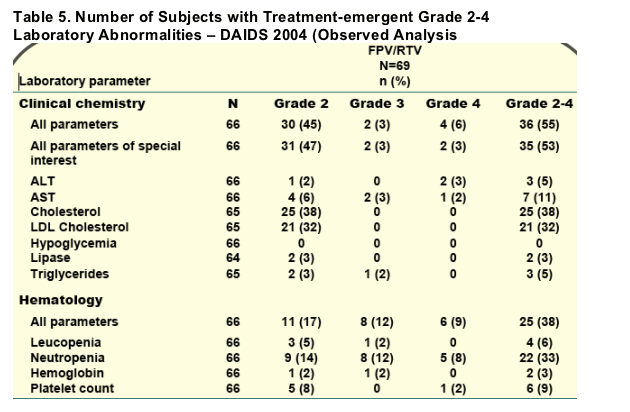
Overall, the incidence of treatment-emergent Grade 3/4 hematology laboratory abnormalities was 21% (14/66) and manifest primarily as neutropenia (20%, 13/66). However, neutrophil results from seven subjects were confounded by either concomitant medication (n=3) or sample degradation (n=4).
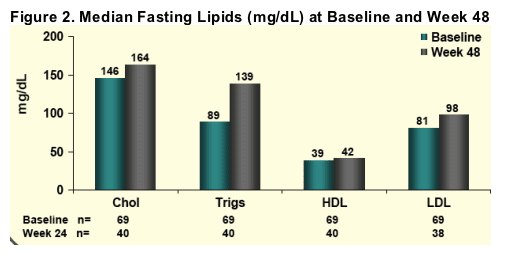
|
| |
|
 |
 |
|
|